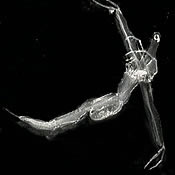| |
|
| |
| Distinguishing Characteristics |
- Body and legs not covered with bivalve carapace
- Six
pairs of legs are somewhat flattened, clearly segmented and
prehensile
- Long body
|
| Ecology |
- Leptodora, the largest planktonic cladoceran, occurs in a wide range of conditions, including clear oligotrophic as well as eutrophic lakes. Little is known about the predatory feeding habits of Leptodora, as it is extremely difficult to culture in the laboratory.
- The prey of Leptodora includes a range of zooplankton such as rotifers and Daphnia. Prey are captured and held with the powerful prehensile legs and manipulated by accessory grasping appendages.
- The compound eye of this cladoceran is well adapted to life in the plankton. Each of the approximately 500 ommatidia forms a cone made up of five cells that are uniquely designed to minimize shading and thus making this large eye relatively invisible to visual predators (1).
- Young Leptodora are hatched from eggs in the brood pouch, which is formed by the diminutive carapace. Development of Leptodora is very unusual, for unlike all other cladocera, young hatch as nauplii larvae and later transform into the characteristic form of the adult. Nauplii from parthenogenic eggs hatch and develop in the brood pouch, whereas Leptodora nauplii hatched from resting eggs occur free living in the plankton.
|
| Additional Pictures |
|
|
| Quicktime Movies |
- leptodora1.mov -Leptodora
kindti swimming. L.
kindti are very transparent and difficult to see. -
(823 KB)
- leptodora2.mov -Leptodora kindti swimming and bending. - (905 KB)
|
| References |
| (1) Nilsson, E., R. Odselius and R. Elofsson. 1983. The compound eye of Leptodora kindtii (Cladoceran). An adaption to planktonic life. Cell Tissue Res.30: 401-410. |





